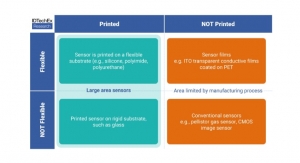Sean Milmo, European Editor07.12.17
The European flexible electronics sector is stepping up its efforts, with public sector assistance, to bridge the gap between laboratory and commercial-scale manufacturing in product development.
The existence of the gap, dubbed the “valley of death” by the research community because funds and other support tend to dry up when proof of concept has been achieved, is seen currently as being a major barrier to the commercialization of flexible electronic innovations, particularly advanced ones.
In particular, it is deterring SMEs worried about the dangers of running into financial difficulties with R&D projects.
“(There is a need to) lower the risk of the decision for SMEs to enter the market,” Elena Turco, program manager at Amires, a Czech-based R&D consultancy, told the International Symposium on Flexible Organic Electronics (ISFOE17), Thessalonika, Greece, in early July.
The European Union and European national governments have tended to restrict R&D funding in electronics and other key technology sectors to the research required for proof of concept in the laboratory. In some cases, it may be extended to cover work on the integration of components so that products can be tested in a simulated environment as a prototype.
In the system of technology readiness levels (TRLs) for classifying R&D stages, this is equivalent to TRL 6, with the stage for full-scale production readiness being TRL 9.
Now the EU, through Horizon 2020, its current seven-year research program, and national governments are extending the coverage of their research funds to TRL7, which involves demonstrating a product in an operational environment. But funds tend not to be allocated to TRL 8 research, in which the innovation is tested when incorporated into the product of its end users, such as an automobile or a building.
In printed electronics, the EU research projects now consist of pilot line schemes in which the partners provide the materials, equipment and other services required to make a final product.
Once research reaches TRL 7. it starts to overlap with first stages of development of products for full-scale manufacture undertaken by the industrial end-users themselves.
“These evaluations cost money,” said Corne Rentrop, project coordinator for the EU-funded InSCOPE research project for hybrid thin organic large area electronics (H-TOLAE. “Companies have to make samples in large quantities for assessments like consumer acceptance tests. This can be expensive in sectors like smart packaging. The end-user wants to be sure that the quality and reliability levels meet their standards.”
InSCOPE is an open access pilot line service aimed at improving production processes, functionality and reliability mainly for OLED developers. to an extent enabling the innovator to provide samples of high quality and in quantities necessary for industrial qualification. The end-user applications being targeted are in automotive, healthcare, smart packaging and buildings.
In addition to the scheme’s coordinator Holst Centre of the Netherlands Organisation for Applied Scientific Research (TNO), its 10 partners include the UK’s Centre for Process Innovation (CPI), VTT Research OrganiZation of Finland, Philips Lighting of the Netherlands, Robert Bosch GmbH of Germany and GlaxoSmithKline (GSK), the UK-based pharmaceuticals manufacturer.
When the three-year research project is completed at the end of 2019, it will continue as an independent services organization probably owned by the current partners as a co-operative.
InSCOPE follows a similar open-access strategy to PI-SCALE, another pan-European research scheme aimed at facilitating the mass production of OLEDs. The difference is that InSCOPE is more focused on the evaluation of samples in the operational environment aimed at specific applications.
PI-SCALE is a €16 million pilot line scheme dealing with needs for the validation of the upscaling concepts and of systems for the integration of components into the final product.
Its partners include the Holst Centre, which is also acting as coordinator, VTT and Fraunhofer Institute of Germany. They also have a number of end-users such as Audi, emdedesign and REHAU, all of Germany, and Pilkington Technology Management of the UK.
PI-SCALE is one of three current pilot-line research projects of Europe’s Photonics Public Private Partnership (PPP) funded by the EU and the photonics private sector, which has 370,000 employees in Europe and a 55% share of the global production technology market in photonics.
In addition to PI-SCALE, the other two pilot-line schemes are a laser-based sensing device and a photonics platform for health applications, including a silicon nitride-based technology for low-cost detection and imaging systems. The EU has allocated a total of €700 million to photonics research projects through the photonics PPP.
With most of the EU-funded research schemes, participants have to undertake to commercialize innovations that advance successfully through the project’s development stages.
“The partners (in our project) have made a basic commitment to commercializing the technology in their part of the value chain,” said Giles Lloyd of UK-based Merck Chemicals Ltd, the coordinator of ATLAAS, an EU-backed smart sensors research scheme. “By the end of the project (in 18 months) they should have drawn up a detailed business plan for this commercialization, which may involve further collaboration with the existing partners in the project.
“Merck, for example, has committed to upscale its materials used within the project ready for mass production in terms of quality and quantity as per market requirements,” he added.
However, in the later stages of flexible electronics research schemes both at the EU and the national levels, problems are emerging that could delay commercialization.
Among the most promising of the current nationally funded schemes is Konfekt, funded by the German government, which is developing a flexible ultra-thin glass that can be processed into an electronic substrate on a roll-to-roll process. The partners comprise the coordinator, Fraunhofer Institute’s Organics Electronics, Electron Beam and Plasma Technology division (FEP), specialty glass maker Schott AG, the specialty adhesive tape producer tesa SE and the German equipment manufacturer VON ARDENNE GmbH.
“We still have challenges to overcome before the technology is ready for mass production in mid-2018 when the research project is completed,” said Michael Mueller, Schott’s public relations manager. “The technology has to be scaled up and there is the problem of taking the glass off the roll without breakages.”
Also, there could be difficulties further downstream when the large-area coated glass is divided into sections for specific applications, according to Fraunhofer FEP.
“At the moment we don’t have a technology which ensures sufficient cutting edge stability,” said Stefan Mogck, deputy manager for R2R at Fraunhofer FEP in Dresden. The institute is considering a research collaboration with a laser equipment maker or joining a suitable German-funded research consortium to resolve the problem.
In the gap between laboratory development and full-scale production, some of the biggest obstacles arise in the late stages close to commercialization. The big question is how much the public sector will be willing to fund research to resolve these problems.
The existence of the gap, dubbed the “valley of death” by the research community because funds and other support tend to dry up when proof of concept has been achieved, is seen currently as being a major barrier to the commercialization of flexible electronic innovations, particularly advanced ones.
In particular, it is deterring SMEs worried about the dangers of running into financial difficulties with R&D projects.
“(There is a need to) lower the risk of the decision for SMEs to enter the market,” Elena Turco, program manager at Amires, a Czech-based R&D consultancy, told the International Symposium on Flexible Organic Electronics (ISFOE17), Thessalonika, Greece, in early July.
The European Union and European national governments have tended to restrict R&D funding in electronics and other key technology sectors to the research required for proof of concept in the laboratory. In some cases, it may be extended to cover work on the integration of components so that products can be tested in a simulated environment as a prototype.
In the system of technology readiness levels (TRLs) for classifying R&D stages, this is equivalent to TRL 6, with the stage for full-scale production readiness being TRL 9.
Now the EU, through Horizon 2020, its current seven-year research program, and national governments are extending the coverage of their research funds to TRL7, which involves demonstrating a product in an operational environment. But funds tend not to be allocated to TRL 8 research, in which the innovation is tested when incorporated into the product of its end users, such as an automobile or a building.
In printed electronics, the EU research projects now consist of pilot line schemes in which the partners provide the materials, equipment and other services required to make a final product.
Once research reaches TRL 7. it starts to overlap with first stages of development of products for full-scale manufacture undertaken by the industrial end-users themselves.
“These evaluations cost money,” said Corne Rentrop, project coordinator for the EU-funded InSCOPE research project for hybrid thin organic large area electronics (H-TOLAE. “Companies have to make samples in large quantities for assessments like consumer acceptance tests. This can be expensive in sectors like smart packaging. The end-user wants to be sure that the quality and reliability levels meet their standards.”
InSCOPE is an open access pilot line service aimed at improving production processes, functionality and reliability mainly for OLED developers. to an extent enabling the innovator to provide samples of high quality and in quantities necessary for industrial qualification. The end-user applications being targeted are in automotive, healthcare, smart packaging and buildings.
In addition to the scheme’s coordinator Holst Centre of the Netherlands Organisation for Applied Scientific Research (TNO), its 10 partners include the UK’s Centre for Process Innovation (CPI), VTT Research OrganiZation of Finland, Philips Lighting of the Netherlands, Robert Bosch GmbH of Germany and GlaxoSmithKline (GSK), the UK-based pharmaceuticals manufacturer.
When the three-year research project is completed at the end of 2019, it will continue as an independent services organization probably owned by the current partners as a co-operative.
InSCOPE follows a similar open-access strategy to PI-SCALE, another pan-European research scheme aimed at facilitating the mass production of OLEDs. The difference is that InSCOPE is more focused on the evaluation of samples in the operational environment aimed at specific applications.
PI-SCALE is a €16 million pilot line scheme dealing with needs for the validation of the upscaling concepts and of systems for the integration of components into the final product.
Its partners include the Holst Centre, which is also acting as coordinator, VTT and Fraunhofer Institute of Germany. They also have a number of end-users such as Audi, emdedesign and REHAU, all of Germany, and Pilkington Technology Management of the UK.
PI-SCALE is one of three current pilot-line research projects of Europe’s Photonics Public Private Partnership (PPP) funded by the EU and the photonics private sector, which has 370,000 employees in Europe and a 55% share of the global production technology market in photonics.
In addition to PI-SCALE, the other two pilot-line schemes are a laser-based sensing device and a photonics platform for health applications, including a silicon nitride-based technology for low-cost detection and imaging systems. The EU has allocated a total of €700 million to photonics research projects through the photonics PPP.
With most of the EU-funded research schemes, participants have to undertake to commercialize innovations that advance successfully through the project’s development stages.
“The partners (in our project) have made a basic commitment to commercializing the technology in their part of the value chain,” said Giles Lloyd of UK-based Merck Chemicals Ltd, the coordinator of ATLAAS, an EU-backed smart sensors research scheme. “By the end of the project (in 18 months) they should have drawn up a detailed business plan for this commercialization, which may involve further collaboration with the existing partners in the project.
“Merck, for example, has committed to upscale its materials used within the project ready for mass production in terms of quality and quantity as per market requirements,” he added.
However, in the later stages of flexible electronics research schemes both at the EU and the national levels, problems are emerging that could delay commercialization.
Among the most promising of the current nationally funded schemes is Konfekt, funded by the German government, which is developing a flexible ultra-thin glass that can be processed into an electronic substrate on a roll-to-roll process. The partners comprise the coordinator, Fraunhofer Institute’s Organics Electronics, Electron Beam and Plasma Technology division (FEP), specialty glass maker Schott AG, the specialty adhesive tape producer tesa SE and the German equipment manufacturer VON ARDENNE GmbH.
“We still have challenges to overcome before the technology is ready for mass production in mid-2018 when the research project is completed,” said Michael Mueller, Schott’s public relations manager. “The technology has to be scaled up and there is the problem of taking the glass off the roll without breakages.”
Also, there could be difficulties further downstream when the large-area coated glass is divided into sections for specific applications, according to Fraunhofer FEP.
“At the moment we don’t have a technology which ensures sufficient cutting edge stability,” said Stefan Mogck, deputy manager for R2R at Fraunhofer FEP in Dresden. The institute is considering a research collaboration with a laser equipment maker or joining a suitable German-funded research consortium to resolve the problem.
In the gap between laboratory development and full-scale production, some of the biggest obstacles arise in the late stages close to commercialization. The big question is how much the public sector will be willing to fund research to resolve these problems.




























